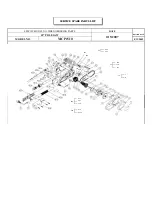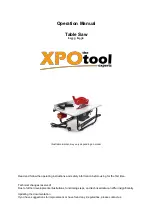
-10-
www.igmtools.com
Pic. 41
Note. Tensioning the blade is covered later in
the manual.
2.
Refit the plastic blanking block.
Note:
The blade must be fully tensioned for
final tracking.
Note:
Never track the blade with the saw
running.
Note.
There is a window on the side of the
bandsaw that allows the blade on the upper
flywheel to be viewed. This will assist you while
you are tracking the blade.
7.4 Tensioning the blade
There are a lot of opinions on how to tension
a blade and if you should buy a blade tension
gauge. Before you purchase a blade tension
gauge, note the following points:
Most blade tension gauges are fitted to the
blade and measure the amount the blade
stretches when you tension it. Each blade
manufacturer uses a different type of steel with
different tensile strength. This means that each
type of steel has a different rate of stretch. For
example, if you buy a tension gauge from one
blade manufacturer, it is designed for use on
their blades, or range of blades, and will not
necessarily give you accurate readings in lbs/
square inch on another manufacturer’s blades
because their blades stretch at a different rate.
In reality, there is nothing quite as quick or as
accurate as experience. Your machine is fitted
with a blade tension indicator, which measures
the deflection of the tension spring on the upper
flywheel. We recommend that you use it only
as a general guide and use one of the following
tensioning procedures to tension the blade.
Pic. 42
Pic. 43
Pic. 44
Method 1
Looking at the top wheel, place your finger at
the 9 o‘clock position. Move your finger down
6“, and, using moderate pressure with your
thumb, press on the flat of the blade. You
should get 3/16“ to 1/4“ of deflection. Refit all
the guards and close the doors. Replace the
table insert and check that the blade moves
freely through the table insert. Check that all
wrenches and loose parts are removed from
the machine. Plug the machine into the power.
Turn the machine on for a second and switch
off. Watch how the blade runs. If the blade
tracks well, then run the machine at full power.
If the blade tracking needs adjustment, repeat
adjustment.
Method 2
Tension the blade as described in method 1.
Close all the doors and ensure that all the
guards are fitted. Start the band saw and look
at the blade from the front of the machine. Start
to detension the blade very slowly until the
blade starts to flutter (wobble from side to side).
Then start to tension the blade until the blade
stops fluttering and is running true. Increase
the tension on the blade by one complete turn
on the tension handle. You may find that each
size and type of blade will need more or less
additional tension. For example, a 1/16“ blade
will need less additional tension than a 3/4“
blade. Again, experience is the key, and with a
little practice it will become second nature. The
key to all tensioning is to get the blade to cut
straight and true with the minimum amount of
tension. The less tension that you put on the
blade, the longer the blade and the machine
will last.
Note.
The upper flywheel has a spring that is
used to keep a constant pressure on the blade
during use. As the blade cuts, heat is
generated, which causes the blade length
to expand. The spring compensates for the
change in length, and you must never bottom
out the spring while tensioning the blade.
Note.
If you are not using the bandsaw for
extended periods of time (overnight), remove
the tension on the blade. This will increase
the life of your blade and the machine. If
tension is left on the machine, flats or grooves
can be formed in the rubber of the wheels,
which will detract from the performance of the
machine and in extreme cases cause vibration.
Removing the tension will greatly enhance the
life of the machine, bearings and tires.
Label the machine “detensioned.” On the label,
mark the number of turns that you detensioned;
this way you will know how many turns that
you have to put back on to have your blade
correctly tensioned.
Removing the blade from the bandsaw
1. Disconnect the power to the bandsaw.
2. Remove the table split clamp that aligns the
two table halves.
3. Remove all the guards.
4. Remove the table insert.
5. Remove the tension on the upper flywheel.
6. Open the doors and remove the blade from
the wheels (use gloves and eye protection) and
gently slide the blade through the table slot.
7.5 Adjusting the blade guards
Welcome to a new era in bandsawing. You have
purchased a bandsaw with a revolutionary
blade guide system that is designed to give you
years of safe, high-quality bandsawing. Most
blade guides are designed to support the blade
on the sides and either above or below the
side guides at the back of the blade. This can
allow the blade to twist as pressure from the
wood being cut pushes against the back blade
guide. The Laguna Guide eliminates this by
supporting the blade above and below the back
blade guide, giving the blade unsurpassed
stability. The Laguna Guide also incorporates
patented ceramic as the blade support material.
The advantage of this material is its ability to
resist wear, and with care it should give years of
safe service.
Please read the following notes as they
will assist you in getting the optimum
performance from your Laguna guide
system.
As with the roller guide systems, the Laguna
guide system will damage your blade if it is not
adjusted correctly. The guide blocks must not
come in contact with the teeth of the blade. It
is advisable to run the blade by hand with the
guide blocks completely clear of the blade,
and only when you are completely sure that
the blade is running consistently in the correct
position, you may then adjust the surround
guide blocks as detailed in this manual.
Note on using the Laguna ceramic guide
system.
1. When fitting a blade to your bandsaw, adjust
the guide blocks as detailed later and run the
blade by hand through the guide blocks for at
least two complete revolutions.
2. The weld on a new blade may not be
perfectly aligned, and the misalignment could
hit the ceramic blocks (side and back), causing
damage to the blocks or the blade. If the blade
has a bad weld, return it to your blade supplier
or side dress and file the back of the blade as
needed.
3. The back blade guide is manufactured from
ceramic, so as the blade pushes against it,
friction between the blade and the ceramic
occurs. This action generates a certain amount
of sparks. This is normal and will become
less with time as the back of the blade guide
smoothes out the back of the blade.
4. The back blade guide will slowly form a small
grove as the blade is used (this is normal). It
is recommended that for approximately every 8
hours of use, the guide be rotated 15 degrees.
This will ensure that the groove does not
become too deep and will greatly extend
the life of your guide.
Blade in column slot
Blade guard door
Blade tracking
window
Blade tension indicator
Quick action blade
tension lever (activated)
Blade tension wheel











































